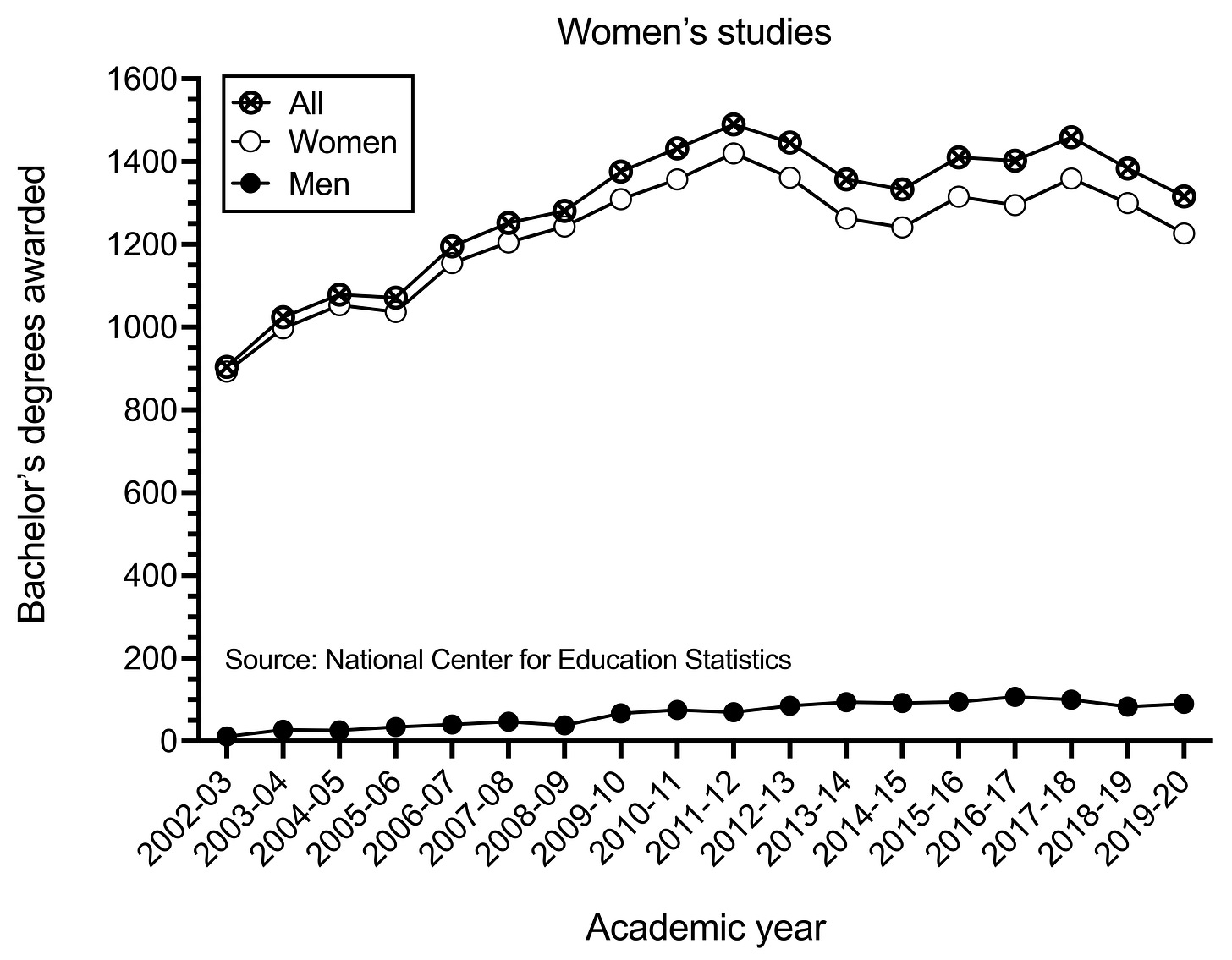The field of women’s studies, sometimes called gender studies, concerns itself with the lives and experiences of girls and women. It is defined by the National Center for Education Statistics in the United States as:
“A program that focuses on the history, sociology, politics, culture, and economics of women, and the development of modern feminism in relation to the roles played by women in different periods and locations in North America and the world. Programs may focus on literature, philosophy, and the arts as much as on social studies and policy.”
This is a forgiving definition, given that feminist academics tend to define the field in more radical ways and that the field is often criticized for its ideological biases. Women’s studies is also rightly criticized for its lack of empiricism, its questionable methodologies and interpretations, and its conflation of scholarship with political activism. The field is also known for propagating unsubstantiated ideas about boys and men, such as “male privilege” and “toxic masculinity” – ideas that hinder a true understanding of the male experience and render male empathy impossible.
Though complaints about the quality of information delivered in women’s studies programs are made regularly within and outside of academic circles, data regarding the field, such as its popularity and growth, are not readily available but could be informative. For example, data on degrees earned over a certain period might serve as a proxy for understanding trends in feminist ideas in the broader mainstream culture.

So, I decided to collate data from the National Center for Education Statistics on the number of bachelor’s, master’s, and doctorate degrees awarded in the field of women’s studies in the United States between the 2002 and 2019 academic school years.
The data reveal that between 2002 and 2011, there was a steady increase in the number of bachelor’s degrees awarded in women’s studies. In 2002, 904 bachelor’s degrees were awarded in women’s studies. In 2011, 1,490 bachelor’s degrees were awarded in the field.
After 2011, there was a slight decrease in number of degrees awarded followed by a plateau, such that, over the past 10 years, approximately 1,400 bachelor’s degrees have been awarded in the field of women’s studies annually.
Over the entire 18-year period from 2002 to 2019, the sum of all bachelor’s degrees awarded in women’s studies in the United States was 23,210. The sum of all master’s degrees awarded was 2,915, with approximately 170 master’s degrees awarded each year. The sum of all doctorate degrees was 319, with approximately 20 doctorate degrees awarded annually.
Unsurprisingly, women have comprised the vast majority of degree earners in women’s studies. Over the 18-year period, 95% of bachelor’s degrees in the field have been awarded to women. Nevertheless, this proportion has changed over time due to increased numbers of men completing such programs. In 2002, women comprised 99% of all bachelor’s degree earners in women’s studies, but by 2019, this number had dropped to 93%.
The total number of degrees earned annually in women’s studies pales in comparison to many other fields. For example, the number of bachelor’s degrees awarded in engineering, psychology, biology, and accounting in 2019 were all over 40,000 each, and many degree programs have grown over this 18-year period. Thus, women’s studies remains on the fringes of academia in terms of enrolment numbers, but the ideas taught in these programs continue to have a large impact on broader culture.
A couple limitations of the data are also worth mentioning:
· First, the data represent degrees awarded. They do not reflect enrolment, nor do they account for dropouts. The data also do not represent the number of courses on women’s studies offered at universities. Thus, the data do not represent the total number of students who are introduced to ideas from women’s studies programs. Some students in other academic majors might take a women’s studies class as a secondary part of their coursework; such exposures are not accounted for in these data.
· Second, the data are specific to the United States. Women’s and gender studies programs are offered at universities in many different countries. Thus, the data may not necessarily reflect global trends in the field.
· Third, not all universities in the United States are reflected in the data. Only universities who participate in Title IV federal financial aid program are required to make these data available to the National Center for Education Statistics. Nevertheless, this is unlikely to significantly impact data related to women’s studies programs because institutions that do not take federal money are typically small, private, and religious institutions, and women’s studies programs are less likely to be offered at such institutions.
· Finally, the data represent degrees categorized by the National Center for Education Statistics as “women’s studies.” The Center also lists degrees for a category called, “ethnic, cultural minority, gender, and group studies.” Approximately 800 bachelor’s degrees in this category are awarded each year. Students in these programs might receive an educational experience similar to that of students enrolled in women’s studies programs. However, such students are not accounted for in the data I have summarized.
To conclude, the number of degrees awarded in the field of women’s studies in the United States has levelled off in recent years following a steady rise between 2002 and 2011. The cause of the plateau is uncertain. Perhaps word has gotten around that a degree in women’s studies is not particularly useful for gaining employment after graduation? Perhaps women are not enrolling in, or are dropping out from, women’s studies programs because they do not want to be lied to about human nature or their own common sense? Or perhaps the cause of the levelling off in degrees earned is something different altogether?
Either way, given that men comprise 50% of the population, and given that the mere existence of the field of women’s studies implies that men and women are not the same, one might then be interested to know whether trends in degrees earned in men’s studies are similar to those summarized here in women’ studies. Such a comparison might inform us of changes in interests in men’s and women’s issues over time. This comparison, however, is not possible. And the reason it is not possible is because the total number of degrees awarded in the field of men’s studies in the United States between the years 2002 and 2020 was zero.
If you appreciated the time it took to retrieve and organise these data from government spreadsheets, design them into a graph, and then present them in a fairly coherent way, then please consider supporting The Nuzzo Letter with a one-time or recurring donation. Your support is greatly appreciated. It helps me to work on independent research projects such as this one. To donate, click the DonorBox log below. In two simple steps, you can donate using ApplePay, PayPal, or another service. Thank you.









Women’s studies – on the rise or fading away?